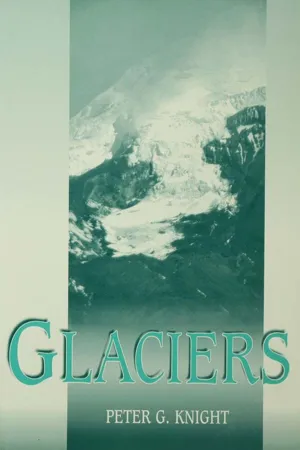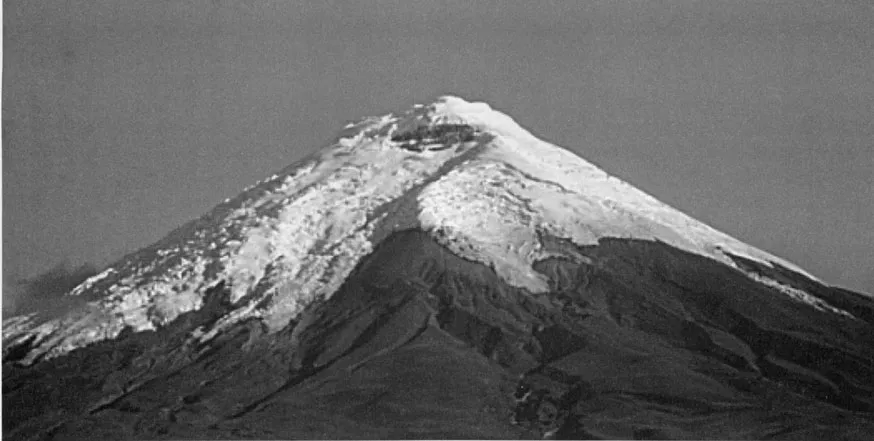![]()
1 Introduction
1.1 This Book
The aim of this book is to provide an up-to-date introduction to the study of glaciers. It is intended to be of value not only to researchers and advanced students, but also to undergraduates and non-professionals with an interest in glaciers. The book is organised so that it can either be read sequentially from start to finish as a review of the subject, or, with the help of the index, used as a source of reference to specific topics.
Glaciology is a relatively young discipline, but one that has developed quickly and continues to do so. The study of glaciers is a huge and expanding field. In recent years, several major leaps in our understanding of glaciers have been heralded as new paradigms in glaciology, and readers who are not intimately involved in the discipline can quickly fall behind new developments. Much of the existing glaciological literature is indigestible to all but the most expert readers, and many of the excellent glacier-related texts that presently exist cover only parts of the glacier story (e.g. Souchez and Lorrain, 1991; Paterson, 1994) or spread their attention far into neighbouring disciplines (e.g. Sugden and John, 1976; Hambrey, 1994; Bennett and Glasser, 1996; Benn and Evans, 1998). This book focuses directly on glaciers, and aims to incorporate discussion of recent developments in glaciology while remaining accessible to a broad readership. The mathematical content of the book is deliberately kept at a low level to facilitate ease of reading; there is no shortage of glaciological literature available for more mathematically inclined readers.
Glaciers and glaciology have focused the attention of a growing international research community for a little more than 150 years. They are staple components of educational courses at all levels in a range of subjects including Geography, Geology, Earth and Environmental Science and Geophysics. In recent geological history 30% of the Earth's land surface has been covered by glaciers. At present, 10% of the land is permanently ice-covered, and a further 10% is permanently frozen. About 50% of the land is covered by snow and ice in the northern-hemisphere winter. More than 75% of the world's fresh water is contained in glaciers, which provide irrigation water for some of the most densely populated areas of the world. The development potential of large areas of our planet is dependent on our ability to mitigate glacial hazards, to harness glacial resources, and to penetrate the glacial barrier to the immense terrestrial and marine resources of the polar regions. The whole global environment is dominated by the planet's glacial character, and an understanding of the Earth's surface is impossible without an understanding of glaciers. Recently, popular scientific attention has been drawn to global environmental issues. Changing climate and sea-level have become major concerns, and a profusion of recent literature has focused on Quaternary environments and environmental change. A major component of past and future environmental change is the planet's glacier system, and glaciers are now recognised as key players in the drama of the global environment. Modelling of the global environment therefore requires a detailed understanding of the characteristics and behaviour of glaciers. A major goal of glaciology must be to close the gap between the simplifications that fuel much of the environmental modellers' output and the reality of how glaciers behave.
If nature had not been invested with glaciers, it would have taken a bold writer of science fiction to invent them, and it is unlikely that they would have been imagined to be either as complex, or as important to the planet, as in fact they are. This book examines the physical characteristics of glaciers, their role in different parts of the global system, and the interest shown in them by the scientific community.
1.2 Types of Glacier
A glacier is a body of ice originating on land by the recrystallisation of snow or other forms of solid precipitation and showing evidence of past and present flow.
(Meier, 1964)
Ice exists in many different forms and contexts in the geographical environment, but not all ice masses are properly referred to as glaciers. Meier's (1964) definition, at the head of this section, indicates two key criteria: glaciers are made of ice formed from the accumulation of precipitation; and glaciers flow. Thus, for example, lake ice or sea ice formed by freezing of a water surface is not a type of glacier; so there is no glacier at the North Pole. Similarly, ground ice formed by segregation and freezing of water in the earth is not a type of glacier. Even using this restrictive definition, however, it is possible to identify many different types of glacier. Attempts at glacier classification have been made for almost as long as glaciers have been scientifically studied. Over one hundred years ago, Rink (1877) made a distinction between the Greenland glaciers and what he referred to as glaciers of the 'temperate zone'. Types of glacier have been defined in a variety of different ways, and there is a classification scheme to suit most purposes. However, inconsistencies in terminology between different systems of classification can hamper scientific communication. The value of classification in general can be questioned, since any individual glacier could be fitted into a variety of alternative categories depending on the classification scheme chosen. Different parts of the same glacier might fall into different categories, and there are transitional forms between the categories of most classifications. Each glacier is effectively unique. Nature can provide an exception to any scheme of classification. Nevertheless, classifications are valuable in providing a shorthand description of glaciers, and in identifying shared characteristics or differences that have implications for aspects of glacier study. Most classifications have focused on three main issues: thermal characteristics, dynamic characteristics and morphological characteristics. These are considered in the following paragraphs.
Lagally (1932), Ahlmann (1933, 1935, 1948) and Court (1957) made early contributions to a classification that is still widely in use to differentiate between glaciers with different thermal characteristics. In the so-called Lagally-Ahlmann classification the key distinction is between glaciers in which the ice is at the pressure melting point throughout the body of the glacier (warm or temperate glaciers), glaciers where the ice is below the melting point throughout (cold, high-polar or high-arctic glaciers), and glaciers where most of the ice is cold but the upper portion of the glacier is at the melting point for part of the year (transitional, sub-polar or sub-arctic glaciers). More recent contributions have identified problems with this simple classification. For example, the geographic and stratigraphic distribution of temperature zones in transitional or sub-polar glaciers can occur in a variety of configurations, and processes operating at the bed of warm or temperate glaciers generate temperature variations that cause areas of the bed periodically to fall below the melting point (Robin, 1976; Goodman et al, 1979). Most glaciers are in fact polythermal, which is to say that they have different thermal characteristics in different parts. Nevertheless, recognition of the thermal characteristics of glaciers, or of specific parts of glaciers, is valuable in predicting rheology, basal sliding, geomorphology and hydraulic activity. The thermal classification is widely employed, and thermal characteristics are used especially often in referring to the base of a glacier. Basal thermal regime is particularly important to glacier behaviour; cold-based and warm-based glaciers exhibit quite different characteristics in basal processes such as sliding and erosion.
Glaciers can be classified in terms of their dynamic characteristics, and referred to as active, passive, or dead (Embleton and King, 1968). In recent literature, this terminology has not been widely adopted in a formal sense, although informal usage persists. Active glaciers experience a strong throughput of ice, usually associated with a strong mass balance gradient (Chapter 3). Where the supply of ice and the rate of movement are low, glaciers can be termed passive, and when the ice is stationary, for example in the terminal area of a surging glacier immediately following a surge, it can be referred to as dead. As in the thermal classification, problems can arise in applying the dynamic classification to whole glaciers, as different parts of the same glacier may be in different dynamic states.
Morphological classification is based on the size and shape of glaciers, and their relationship to the topography over which, or through which, they flow. A basic distinction can be drawn between glaciers which are constrained by topography (such as cirque glaciers, valley glaciers and small ice fields), and those which are not (such as ice caps and ice sheets). Within these classes, glaciers are differentiated by shape, size and setting. For example, a distinction is sometimes drawn on the basis of scale between ice caps (less than 50,000 km2) and ice sheets (more than 50,000 km2) (Armstrong et al., 1973). Classifications of this type have been summarised by Embleton and King (1968) and Sugden and John (1976). As with most classifications it is possible to find examples of glaciers which do not fit comfortably into this morphological scheme. A particular problem is that many glaciers which are commonly
Figure 1.1 The summit ice cap of the volcano Cotopaxi, Ecuador.
referred to as ice caps are in fact not unconstrained by topography. For example, mountain ice caps such as those which picturesquely adorn the peaks of many mountains are unconstrained only in that they entirely envelop their surroundings (Figure 1.1). The pattern of ice flow within these mountain ice caps, and their surface profiles, are controlled not purely by the rheology and internal dynamics of the ice mass, as would be true of a wholly unconstrained glacier, but primarily by the form of the underlying topography. This type of glacier might more properly be referred to as an ice carapace. A more valuable morphological classification could be derived by distinguishing between ice sheets, which derive their characteristics largely from ice flow properties and internal dynamics, and ice caps, which are largely conditioned in their flow regime and surface morphology by the underlying topography. Because terminology has grown up over many years and classifications have been produced in different contexts, a wide range of glacier types are now referred to in the literature. Some of the most frequently used terms are identified and defined below.
Ice sheets are large ice masses (sometimes defined as larger than 50,000 km2) that submerge underlying topography and develop surface profiles and flow patterns that are largely controlled by ice flow properties rather than by topographic constraints. The Greenland and Antarctic ice sheets are the only ones that exist at present, but others have existed during former glacial periods, including the Laurentide ice sheet that covered the northern part of North America and was larger than the present-day Antarctic ice sheet. The two sections of the Antarctic ice sheet, East and West, are sometimes referred to as separate ice sheets although they coalesce to form a single ice mass. Marine ice-sheets are based on bedrock that lies predominantly below contemporary sea-level. They drain mainly by ice streams that feed into the ocean or into attached ice shelves. The West Antarctic ice sheet is the only marine ice sheet existing at present. Ground-based ice sheets rest on bedrock that is above contemporary sea-level. Ice sheets may incorporate ice domes and various types of outlet glacier. Ice domes form the central parts of ice sheets, where snow accumulates and from which ice flows outwards. The Greenland ice sheet, for example, comprises a large northern dome and a smaller southern dome. Outlet glaciers are extensions from the periphery of the sheet where the thinning ice becomes constrained by local topography, and can take any of the wide range of forms adopted by valley glaciers (described below). The terms glacier lobe and ice-sheet lobe are applied to outlet glaciers that are as wide as they are long, and to any identifiable prominence or bulge of an ice sheet or glacier margin. Lobes tend to extend into low-lying areas while higher ground forms embayments or r...

